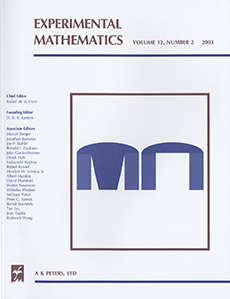Abstract
For odd $v \geq 5$, Schmerl and Spiegel have proved that the $1$-additive sequence $(2,v)$ has precisely two even terms and, consequently, is regular. For $5 \leq v \equiv 1 \bmod{4}$, we prove, using a different approach, that the $1$-additive sequence $(4,v)$ has precisely three even terms. The proof draws upon the periodicity properties of a certain ternary quadratic recurrence.
Unlike the case of $(2,v)$, the regularity of $(4,v)$ can be captured by expressions in closed form. For example, its period can be written as an exponential sum of binary digit sums. Therefore the asymptotic density $\Delta (v)$ of $(4,v)$ tends to $0$ as $v \to \infty$, but is misbehaved in the sense that
$$ \eqalign{ \liminf_{\textstyle{\vrule height 5pt width 0pt v \to \infty\atop v \equiv 1 \bmod{4}}} \left(\frac{v}{2}\right)^{2-\log_23}\Delta (v)=\quarter,\cr \limsup_{\textstyle{v \to \infty\atop v \equiv 1 \bmod{4}}} \left(\frac{v}{2}\right)^{2-\log_23}\Delta (v)> 0.27164.} $$
This is proved using techniques adapted from Harborth and Stolarsky.
Citation
Julien Cassaigne. Steven R. Finch. "A class of {$1$}-additive sequences and quadratic recurrences." Experiment. Math. 4 (1) 49 - 60, 1995.
Information




